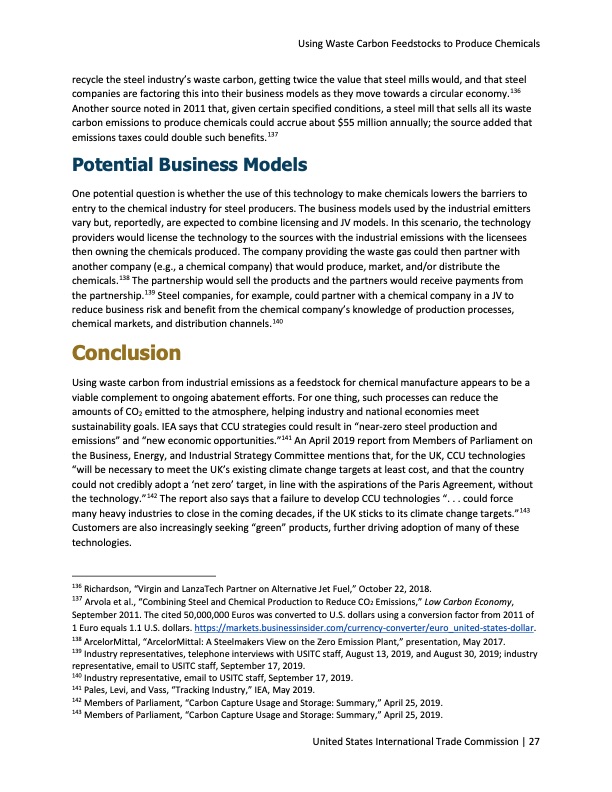
PDF Publication Title:
Text from PDF Page: 027
Using Waste Carbon Feedstocks to Produce Chemicals recycle the steel industry’s waste carbon, getting twice the value that steel mills would, and that steel companies are factoring this into their business models as they move towards a circular economy.136 Another source noted in 2011 that, given certain specified conditions, a steel mill that sells all its waste carbon emissions to produce chemicals could accrue about $55 million annually; the source added that emissions taxes could double such benefits.137 Potential Business Models One potential question is whether the use of this technology to make chemicals lowers the barriers to entry to the chemical industry for steel producers. The business models used by the industrial emitters vary but, reportedly, are expected to combine licensing and JV models. In this scenario, the technology providers would license the technology to the sources with the industrial emissions with the licensees then owning the chemicals produced. The company providing the waste gas could then partner with another company (e.g., a chemical company) that would produce, market, and/or distribute the chemicals.138 The partnership would sell the products and the partners would receive payments from the partnership.139 Steel companies, for example, could partner with a chemical company in a JV to reduce business risk and benefit from the chemical company’s knowledge of production processes, chemical markets, and distribution channels.140 Conclusion Using waste carbon from industrial emissions as a feedstock for chemical manufacture appears to be a viable complement to ongoing abatement efforts. For one thing, such processes can reduce the amounts of CO2 emitted to the atmosphere, helping industry and national economies meet sustainability goals. IEA says that CCU strategies could result in “near-zero steel production and emissions” and “new economic opportunities.”141 An April 2019 report from Members of Parliament on the Business, Energy, and Industrial Strategy Committee mentions that, for the UK, CCU technologies “will be necessary to meet the UK’s existing climate change targets at least cost, and that the country could not credibly adopt a ‘net zero’ target, in line with the aspirations of the Paris Agreement, without the technology.”142 The report also says that a failure to develop CCU technologies “. . . could force many heavy industries to close in the coming decades, if the UK sticks to its climate change targets.”143 Customers are also increasingly seeking “green” products, further driving adoption of many of these technologies. 136 Richardson, “Virgin and LanzaTech Partner on Alternative Jet Fuel,” October 22, 2018. 137 Arvola et al., “Combining Steel and Chemical Production to Reduce CO2 Emissions,” Low Carbon Economy, September 2011. The cited 50,000,000 Euros was converted to U.S. dollars using a conversion factor from 2011 of 1 Euro equals 1.1 U.S. dollars. https://markets.businessinsider.com/currency-converter/euro_united-states-dollar. 138 ArcelorMittal, “ArcelorMittal: A Steelmakers View on the Zero Emission Plant,” presentation, May 2017. 139 Industry representatives, telephone interviews with USITC staff, August 13, 2019, and August 30, 2019; industry representative, email to USITC staff, September 17, 2019. 140 Industry representative, email to USITC staff, September 17, 2019. 141 Pales, Levi, and Vass, “Tracking Industry,” IEA, May 2019. 142 Members of Parliament, “Carbon Capture Usage and Storage: Summary,” April 25, 2019. 143 Members of Parliament, “Carbon Capture Usage and Storage: Summary,” April 25, 2019. United States International Trade Commission | 27PDF Image | Using Waste Carbon Feedstocks to Produce Chemicals

PDF Search Title:
Using Waste Carbon Feedstocks to Produce ChemicalsOriginal File Name Searched:
using_waste_carbon_feedstocks_to_produce_chemicals.pdfDIY PDF Search: Google It | Yahoo | Bing
NFT (Non Fungible Token): Buy our tech, design, development or system NFT and become part of our tech NFT network... More Info
IT XR Project Redstone NFT Available for Sale: NFT for high tech turbine design with one part 3D printed counter-rotating energy turbine. Be part of the future with this NFT. Can be bought and sold but only one design NFT exists. Royalties go to the developer (Infinity) to keep enhancing design and applications... More Info
Infinity Turbine IT XR Project Redstone Design: NFT for sale... NFT for high tech turbine design with one part 3D printed counter-rotating energy turbine. Includes all rights to this turbine design, including license for Fluid Handling Block I and II for the turbine assembly and housing. The NFT includes the blueprints (cad/cam), revenue streams, and all future development of the IT XR Project Redstone... More Info
Infinity Turbine ROT Radial Outflow Turbine 24 Design and Worldwide Rights: NFT for sale... NFT for the ROT 24 energy turbine. Be part of the future with this NFT. This design can be bought and sold but only one design NFT exists. You may manufacture the unit, or get the revenues from its sale from Infinity Turbine. Royalties go to the developer (Infinity) to keep enhancing design and applications... More Info
Infinity Supercritical CO2 10 Liter Extractor Design and Worldwide Rights: The Infinity Supercritical 10L CO2 extractor is for botanical oil extraction, which is rich in terpenes and can produce shelf ready full spectrum oil. With over 5 years of development, this industry leader mature extractor machine has been sold since 2015 and is part of many profitable businesses. The process can also be used for electrowinning, e-waste recycling, and lithium battery recycling, gold mining electronic wastes, precious metals. CO2 can also be used in a reverse fuel cell with nafion to make a gas-to-liquids fuel, such as methanol, ethanol and butanol or ethylene. Supercritical CO2 has also been used for treating nafion to make it more effective catalyst. This NFT is for the purchase of worldwide rights which includes the design. More Info
NFT (Non Fungible Token): Buy our tech, design, development or system NFT and become part of our tech NFT network... More Info
Infinity Turbine Products: Special for this month, any plans are $10,000 for complete Cad/Cam blueprints. License is for one build. Try before you buy a production license. May pay by Bitcoin or other Crypto. Products Page... More Info
| CONTACT TEL: 608-238-6001 Email: greg@infinityturbine.com | RSS | AMP |